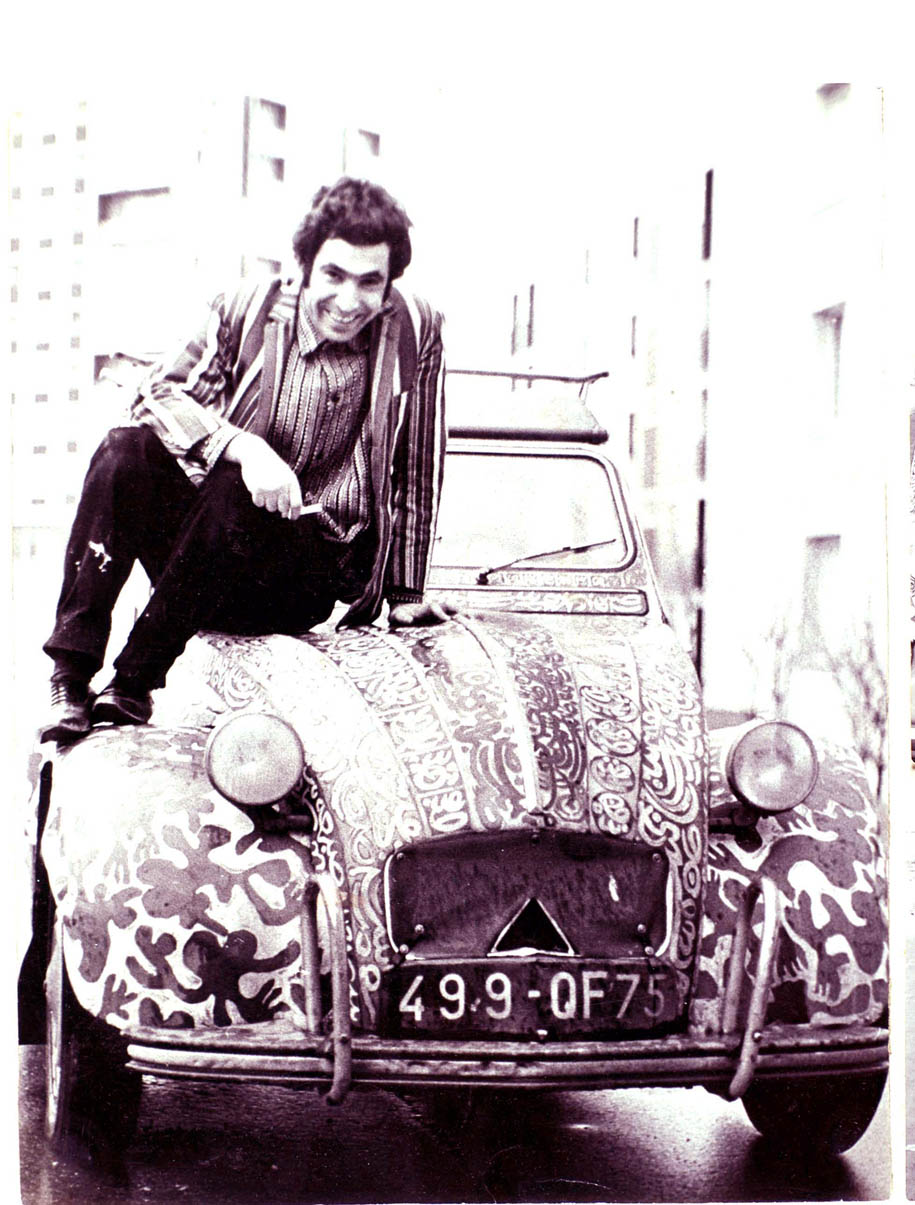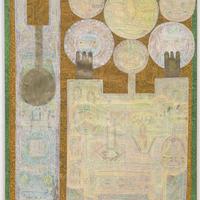More about Charles Hossein Zenderoudi
Works by Charles Hossein Zenderoudi

Contributor
If you look for a universal language of visual art, you can draw parallels between the work of Charles Hossein Zenderoudi and Barbara Kruger, say, or Lawrence Weiner, in that all three artists use verbal meaning as a means of conveying a visual message.
Even Marcel Duchamp made a name for himself by using words and puns to emphasize the extra-rationality of his message.
Zenderoudi is an Iranian, which is to say, a Persian, despite his residence in New York and Paris; it is not enough to say, "this artist uses words," because Zenderoudi's work developed in the context of the particular brand of Shia Islam dominant in Iran, and within the Farsi and Arabic languages. At the same time, we cannot approach such an ambitious topic in English with the idea that this is "foreign to us"--on the contrary, Persia is one of the oldest and most influential civilizations on earth, and Islam translated science, mathematics and logic to Western Europe, introducing ideas like the number zero, algorithms (those things that control social media), algebra, and personal hygiene to Europeans when they desperately needed them. Instead, you have to look at it in terms of a series of limitations and constraints which underlie the Abrahamic philosophies which include Judaism, Christianity, and Islam.
Whereas Christianity emphasized the Talmudic theme of martyrdom, Islam made the concept of the absolute oneness of the divine central to all of its endeavors. This doctrine animates the anti-idolatrous idea of the Abrahamic faiths, which set them apart from their neighbors. In the context of Shia Islam, the state religion of Iran, it is necessary to work within an established school and tradition based on principles accepted by the leadership. It is much more possible to examine the Saqqa-khaneh school of Persian art, of which Zenderoudi is the figurehead, than to devise a biography of him, partly because of cultural considerations and partly because he has never sought individual celebrity.
Zenderoudi's name, Hossein, is a reference to the Shia martyr Hossein, ٱلْحُسَيْن ابْن عَلِي ابْن أَبِي طَالِب, who is associated with Karbala and a passion narrative. The term Saqqa-khaneh means "…the “house" or "place of the water-bearer" and a symbolic tomb, a reminder of…[Divine] Mercy—which is epitomized for the dry lands of the Islamic world in the primordial symbolism of the life-giving water of rain and rivers—and a reminder of the passion of Karbala [the martyrdom of Hossein]."
To uncover the context of the name of Saqqa-khaneh there are many layers of meaning, but it is essentially a reference to a mystical oasis, and shrine, which is a public fountain linked to the martyrdom of the imam.
Over the course of Zenderoudi's life the government of Iran has changed in significant and drastic ways, and these changes may have exerted a larger influence on his work if it were not almost entirely composed of depictions of excerpts from scripture. Established modernists, the Saqqa-khaneh artists draw primarily on the formal and pictorial aspect of the calligraphic tradition. This is how Zenderoudi and his fellow Saqqa-khaneh artists defend their work from clerical criticism. At the same time, such stringent formal constraints have made great artistic achievements possible.
Sources
- Evans, Jessica, and Stuart Hall. Visual Culture: The Reader. New York: SAGE Publishing, 1999.
- Keshmirshekan, Hamid. "Neo-Traditionalism and Modern Iranian Painting: The Saqqa-khaneh School in the 1960s." Iranian Studies 38, no. 4 (Dec. 2005): 1-14.
- Khorshidian, Raika, and Heidar Zahedi. "The Saqqa-khaneh School: Post-Colonialism or Orientalism Perspective?" The Scientific Journal of NAZAR Research Center for Art, Architecture and Urbanism 14, no. 53 (Nov. 2017): 43-56.
- Marks, Laura U. Enfoldment and Infinity: An Islamic Genealogy of New Media Art. Cambridge: MIT Press, 2010
- Seyedi, Bibi Maliheh, Nor Azlin Hamidon, and Lawrence N. Ross. "A Comparative Study of Islamic Calligraphic Painting in Malaysia and Iran." Jurnal Pengajian Melayu, Jilid 28 (2017): 62-84.
- Willson, P.L. “The Saqqa-khaneh.” Catalogue of the Saqqa-khaneh Exhibition. Tehran, 1356/ 1977.
Featured Content
Here is what Wikipedia says about Hossein Zenderoudi
Charles Hossein Zenderoudi (Persian: (شارل) حسین زندهرودی; born March 11, 1937) is an Iranian painter, calligrapher and sculptor, known as a pioneer of Iranian modern art and as one of the earliest artists to incorporate Persian calligraphy elements into his artwork. He is a pioneer of the Saqqakhaneh School of Art, a genre of neo-traditional modern art founded in Iran that is rooted in the history of Persian coffee-house paintings and Persian Shia visual elements. He lives in Paris and New York.
Check out the full Wikipedia article about Hossein Zenderoudi











